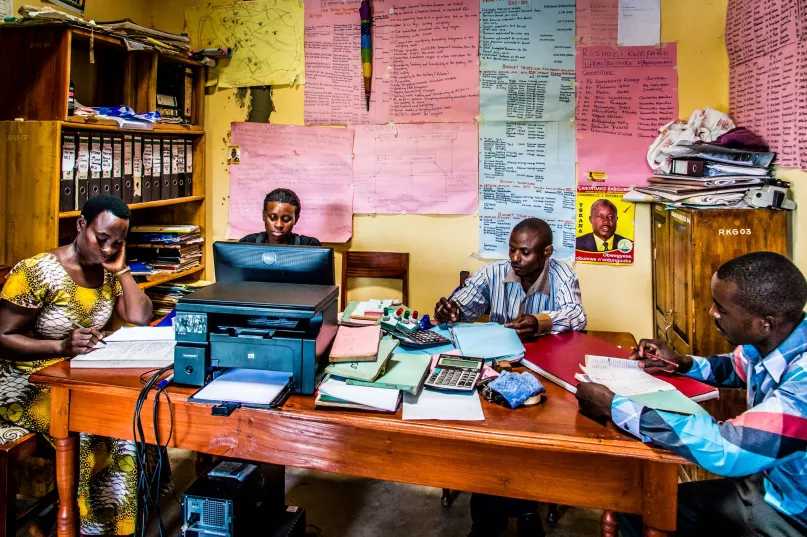COVID-19 Has Made MFI Digital Transformation Even More Urgent: How Can Funders Help?

If digital transformation was a high-priority topic for financial institutions before the global health crisis, COVID-19 and its social distancing requirements have only made it more urgent. Whether financial institutions are still able to communicate with their clients, continue recoveries, and even pursue loan origination, depends mainly on their level of digitalization. Financial institutions with strong digital channels can continue to (partly) operate, while those that still rely primarily on branch-based transactions are putting their staff and clients at risk and - depending on the regulatory situation - may have to stop recoveries and most, if not all, financial services.
At the Belgian Investment Company for Developing Countries (BIO), we wanted to know how we can best support our financial institution clients with digital transformation, and where investors should focus their funds. With the help of PhB Development, we surveyed and interviewed 27 financial institutions.
Figure 1: Overview of financial institutions surveyed

The key challenges that slow down MFIs’ digital transformation
The results show that the larger commercial banks in the sample are far ahead on digitalization, while the microfinance institutions (MFIs) need to catch up and might require support to do so (paper coming soon). For many deposit-taking or credit-only MFIs, their digital product and channel offer is still not very developed. MFIs are held back by legacy IT systems and a lack of expertise, and insufficient funding to address these issues. Without the necessary size and financial power to support heavy IT investments and recruit experts, they struggle to catch up.
Figure 2: Challenges for digitalization for non-commercial banks (MFIs and a few leasing companies)

How technical assistance needs to change
Funding support can thus be a major lever to help MFIs digitalize and should focus on 1) addressing knowledge and capacity gaps, and 2) overcoming the limitations of IT systems.
1. Addressing knowledge and capacity gaps
Traditional technical assistance - consisting of consultant missions for capacity building or institutional assessments - will still be needed to address the lack of digitalization knowledge. Consultant missions can:
- Spread best practice to institutions that are undergoing digital transformation.
- Shed light on the advantages and disadvantages of various technology solutions.
- Make sure audit and risk functions upgrade in line with the technological enhancements.
- Protect institutions from easily avoidable mistakes such as overlooking the importance of change management to overcome the resistance of clients and employees towards digital solutions.
Training programs on both an institutional and a sectoral level can reduce the skill gap and prepare employees - from IT personnel to front-line operations staff - for digital products and channels. Or they can address the literacy challenges that may prevent customer uptake of new products and channels.
Another report based on BIO’s digital portfolio scan has identified an urgent need for putting proper digital transformation strategies in place. Institutional assessments will be necessary to establish the most promising approach in each market and each institutional context, choose IT solutions, prioritize the various steps of digital transformation over time, and identify organizational, process and skill gaps.
2. Overcoming limitations of IT systems
Going forward, digital transformation will require investors to also consider IT support. BIO has recently amended its technical assistance guidelines to be able to support product and software development costs or – under certain conditions – capital expenditure required for the clients’ digital transformation. This is also open to certain digitalization measures under the COVID-19 crisis to ensure that our investees can stay in touch with their customers remotely and continue operations as much as possible.
Another relevant amendment allows BIO to support projects at the group level, as long as it benefits our direct investee. This is aimed at those MFIs which are members of international corporate groups or holding structures. For these microfinance groups, it would be inefficient to address digitalization and IT investments (for example in new core banking systems) separately in each subsidiary, as many of their (digital) investments take place on a group level.
Last but not least, upgrading legacy IT systems or even switching to a modern core banking system altogether can require substantial amounts of funding that one donor alone cannot provide. Going forward, funders will need to team up and coordinate their support to clients they have in common. Jointly, they can leverage amounts large enough to meet the required investments in technology. By working together, they can also help clients see through the jungle of requirements and limitations for what type of expenses each donor can cover, and make sure that projects respect a timeline based on the clients’ needs, not the availability of donor funds.
Beyond COVID – Digital transformation as a question of survival
While lockdowns are being lifted in some markets, the digitalization pressure of the pandemic is expected to persist for at least two years. And the urgency for funders to support the digital transformation of MFIs will persist beyond the effects of coronavirus. It is a matter of survival in the long term.
We have no crystal ball to tell what the digitalized financial inclusion industry will look like 10 years from now, or if financial inclusion will still be separate from mainstream banking. With fintechs and telcos and an increase of commercial banks going down-market, digital transformation has brought new players to the financial inclusion space. It is changing the economics of reaching out to the financially excluded.
Depending on which players win the race for digital transformation and customer convenience, MFIs may be swallowed or replaced by other financial service providers. Or they may retain competitive advantages for remote and low-income clients and may even see unprecedented growth, with much lower interest rates due to the cost efficiencies of digital services and more convenient digital products and services for their clients. We are only at the beginning of the journey and we look forward to working with our clients, supporting them through the challenges, and learning with them along the way.



Every cloud has a silver lining as the saying goes. For most MFIs and individuals the need for digital transformation was already there but some just feared technology.
Now that it is a must those that feared have to embrace it and all for the best. For some like my MFI the cost is the problem and any assistance will be greatly appreciated.
Leave a comment